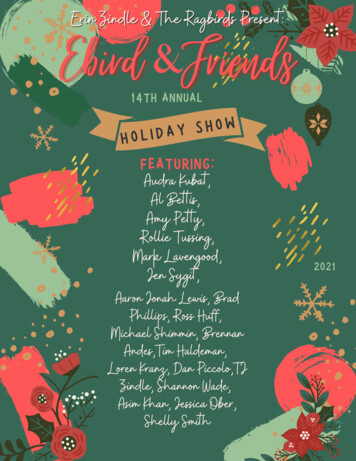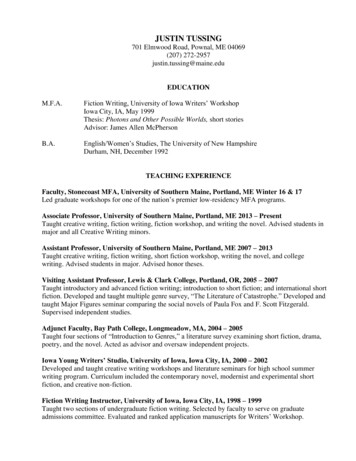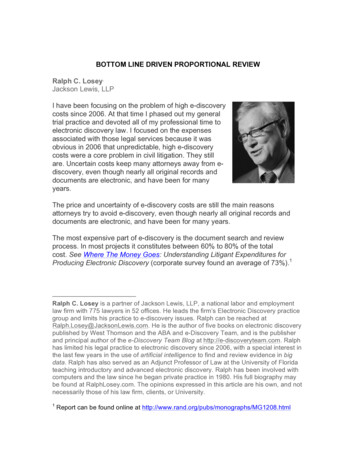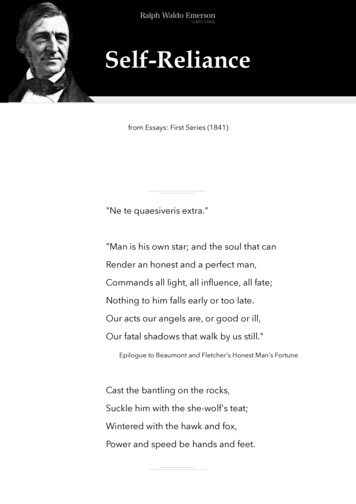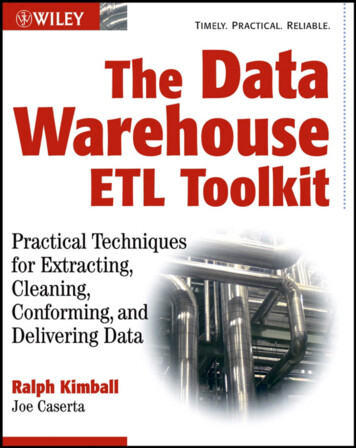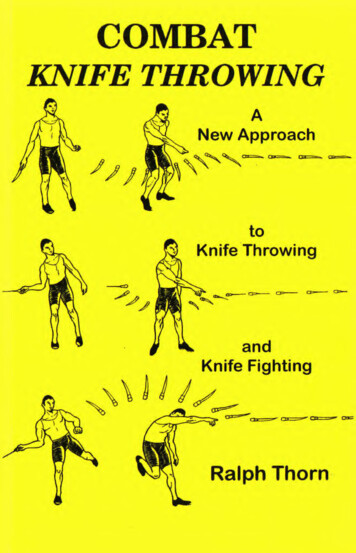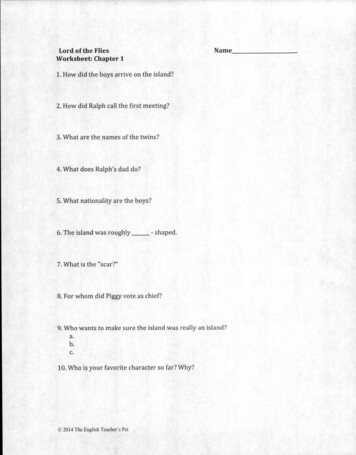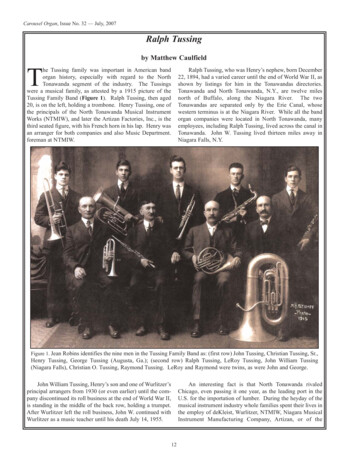
Transcription
Carousel Organ, Issue No. 32 — July, 2007Ralph Tussingby Matthew CaulfieldThe Tussing family was important in American bandorgan history, especially with regard to the NorthTonawanda segment of the industry. The Tussingswere a musical family, as attested by a 1915 picture of theTussing Family Band (Figure 1). Ralph Tussing, then aged20, is on the left, holding a trombone. Henry Tussing, one ofthe principals of the North Tonawanda Musical InstrumentWorks (NTMIW), and later the Artizan Factories, Inc., is thethird seated figure, with his French horn in his lap. Henry wasan arranger for both companies and also Music Department.foreman at NTMIW.Ralph Tussing, who was Henry’s nephew, born December22, 1894, had a varied career until the end of World War II, asshown by listings for him in the Tonawandas directories.Tonawanda and North Tonawanda, N.Y., are twelve milesnorth of Buffalo, along the Niagara River. The twoTonawandas are separated only by the Erie Canal, whosewestern terminus is at the Niagara River. While all the bandorgan companies were located in North Tonawanda, manyemployees, including Ralph Tussing, lived across the canal inTonawanda. John W. Tussing lived thirteen miles away inNiagara Falls, N.Y.Figure 1. Jean Robins identifies the nine men in the Tussing Family Band as: (first row) John Tussing, Christian Tussing, Sr.,Henry Tussing, George Tussing (Augusta, Ga.); (second row) Ralph Tussing, LeRoy Tussing, John William Tussing(Niagara Falls), Christian O. Tussing, Raymond Tussing. LeRoy and Raymond were twins, as were John and George.John William Tussing, Henry’s son and one of Wurlitzer’sprincipal arrangers from 1930 (or even earlier) until the company discontinued its roll business at the end of World War II,is standing in the middle of the back row, holding a trumpet.After Wurlitzer left the roll business, John W. continued withWurlitzer as a music teacher until his death July 14, 1955.An interesting fact is that North Tonawanda rivaledChicago, even passing it one year, as the leading port in theU.S. for the importation of lumber. During the heyday of themusical instrument industry whole families spent their lives inthe employ of deKleist, Wurlitzer, NTMIW, Niagara MusicalInstrument Manufacturing Company, Artizan, or of the12
Carousel Organ, Issue No. 32 — July, 2007carousel manufacturers there, Armitage Herschell, SpillmanEngineering, Herschell Spillman, and Allan Herschell. Forexample, the 1935 directory shows six members of the Wurlfamily working for Wurlitzer.It is commonly believed that Ralph Tussing was a majorarranger of Wurlitzer’s band organ music, but this flies in theface of evidence to the contrary. The Rudolph WurlitzerCompany archives, now in the Archives Center of theSmithsonian Institution’s National Museum of AmericanHistory, ought to be a good source of information. But sadly,whoever was responsible for culling the important from theephemeral when assembling the record of Wurlitzer’s history(1856-1988) was more interested in financial reports, sewerand water maps, and product promotion than in personnelmatters. The most pertinent personnel record in the archive isa payroll ledger from 1918, which lists Wurlitzer’s approximately 700 employees. Ralph Tussing is carried there asemployee #99.The entries are rather cryptic and would require a greatdeal of study to properly interpret them. For each week of theyear all 700 employee names are entered in a neat bookkeeper hand on successive pages. Each employee’s hours andearnings are entered in the appropriate column across thepage, according to the type of work they did during the week.Wages are usually noted as “full” or “cont.” “Cont” probablymeans contract work, but that is not proven. For the week ofJune 6, Ralph Tussing is recorded as working “full” in the category “music rolls, non-productive labor.” Likewise for theweek of June 13, where Ralph was one of seven men soentered.Following the names of the men in the 1918 payrollledger are the names of fourteen females, all but one shown as“cont” and doing “productive labor, music rolls.” The oneexception, Ida Luttman, shown as “full” and doing “non-productive labor, music rolls.” Preserved here in the 1918 payrollledger are probably the identities of the ladies pictured in thewell-known March 1919 photograph of the Wurlitzer roll-perforating room (Figure 3).Figure 3. The music roll department of the Wurlitzer factory.In the weeks of August 1, August 29, and September 26(random samplings), Ralph Tussing is shown as doing “productive labor, instruments.” By the month of December,Ralph was working both in “instruments” and in “musicrolls.” So in 1918, at least, Ralph Tussing was employed in acouple of capacities at the Rudolph Wurlitzer Company,although seemingly as a contract worker, as were manyemployees.A check of the Tonawandas directories shows RalphTussing living in 1923 at 33 Scott Street, Tonawanda, andworking as music arranger for both Wurlitzer and the RandCompany, which had purchased NTMIW in 1917. The 1929directory shows him as a music arranger for Artizan. That isthe last directory to show Ralph working for a band organcompany. Gordon Tussing reports that his father got his startin the band organ business at an early age working at NTMIWwith his cousin, John W. Tussing.In 1930, Ralph is listed as working for “G P Co” (GeneralPlastics). The directories from 1932 to 1935 list him as partner with Edward J. and Harold Tussing in a business operatedout of his Scott Street home called Tussing Delivery. TheTussing Delivery enterprise consisted of trucks picking upgroceries and produce from wholesalers at Buffalo’sWashington Market and delivering them to retail stores in theTonawandas and Niagara Falls. Tussing Delivery continuedoperating after 1935, but Ralph was no longer connected withit. He worked for Durez Company, according to the 1936directory, and then from 1937 to 1946-47 for Spaulding FibreFigure 2. Masters in the library of the HerschellCarrousel Factory Museum showing the name of“Benz”, apparently a Wurlitzer roll departmentinspector.Two names listed there following Ralph’s ring a bell:Fred Benz and Chas. Nelson. Those names may explain someheretofore mysterious notations on many surviving Wurlitzermusic roll masters that are now in the Herschell CarrouselFactory Museum. Some masters have the circled initials"C.N." in blue pencil on their leaders; others have “Benz”flourished in blue on them (Figure 2). It seems clear now thatthese were approval marks by people in the Wurlitzer RollDepartment.13
Carousel Organ, Issue No. 32 — July, 2007Company, manufacturers of Bakelite, where he is shown in the1942 directory as a buffer for Spaulding.At some point while working for the Wurlitzer Company,Ralph lost three fingers of his left hand in a sawing accident.In most photos taken of him, he is careful to conceal the loss.But it didn’t deter Ralph from continuing to play the piano onoccasion in order to arrange music for his music rolls.It appears that Herschell found the band organ businesstoo unprofitable, because they soon divested themselves of thenew operation, selling it to Ralph Tussing and two partners,Ralph’s son Gordon Tussing, Sr., and his son-in-law, LloydRobins. Max Nowicki reportedly wanted to buy the equipment from Herschell, but the Tussings were able to raise themoney before he could (Figure 5). The new business wasincorporated as the T.R.T. Manufacturing Company onJanuary 13, 1947. Its first 125 and 150 rolls appeared inJanuary and February 1947, followed by a 165 roll in early1947.Figure 4. A Wurlitzer letter indicating the sale of the Music RollDepartment to the Allan Herschell Company on September 17, 1945.In 1945, as World War II ended, the Rudolph WurlitzerCompany returned to peacetime work and decided to quit theband organ and music roll business entirely (Figure 4). Onecan imagine the effect this news had on the Allan HerschellCompany, which needed music for its rides. Ralph Tussingrecalls getting a phone call from Herschell’s president/owner,John Wendler, asking him to go to the Wurlitzer plant andselect for Herschell everything that he deemed useful for setting up a band organ department. Ralph was then hired to runthat department. This recollection is not documented, butwhat is known is that Wurlitzer’s last style 125, 150, and 165band organ rolls were issued in early 1945 (February 28 forthe 150 roll) and in 1946, Herschell issued under its own labelone (or two?) style 165 rolls and two style 150 rolls. LouRosa, a Wurlitzer employee at that time, wrote in a letter datedJanuary 14, 1987: “I was responsible for turning over the rollcutting equipment to Ralph Tussing in 1946. The WurlitzerCo. was no longer interested in roll cutting.”Figure 5. Tussing’s letter indicating he had purchased the BandOrgan and Music Roll Department from Allan Herschell.If Herschell was compelled to enter the band organ musicbusiness to ensure that they could offer their customers theproper music, it may be their development of the Merri-Orgthat allowed them to exit the field almost as quickly as theyentered. The Merri-Org was basically a three-speaker soundsystem playing 78-R.P.M. records through a large amplifier,housed in a cabinet behind a band organ façade. For picturesand detailed description of the device, see p. 257-260 of TheAmerican Carousel Organ, by Ron Bopp. The records wereproduced by the Howell Recording Studio, Buffalo, N.Y.,recording at the Herschell factory a band organ playing style165 rolls. The sound is not exactly that of a Wurlitzer 165organ, leading to speculation that Herschell had an organ spe14
Carousel Organ, Issue No. 32 — July, 2007cially made or modified to play Wurlitzer 165 music. JohnWendler, in a cover letter dated June 17, 1948, to DickBowker, Pittsburgh, Pa., attached to a complete list of recordsmade for the Merri-Org, claimed: “These records are actualrecordings of band organ music, made here in our plant froma large band organ which we had built expressly for the purpose of making records.” The Merri-Org allowed Herschell togracefully exit the real band organ business.The T.R.T. Manufacturing Company was originally located at 825 Main Street (now 825 River Road), NorthTonawanda, in an old barn, still standing, but crumbling. Thepaper racks for the two Wurlitzer perforators T.R.T. hadacquired are shorter-legged than the racks shown in oldWurlitzer factory pictures. On being asked about that, GordonTussing admitted that he and his father had sawed off the legsto make the racks fit in a corner of the shop. While it does notappear that Ralph Tussing did much music arranging for theRudolph Wurlitzer Company, he was the arranger for theT.R.T. Manufacturing Company. In fact, T.R.T. was prettymuch a one-man operation, although Ralph did receive someassistance from Gordon, who worked there full time for morethan a year, and along with other family members.Island, where there were five band organs. Wanting to learnband organ work, Gavin went to visit Max Nowicki around1964. Max, who is now 87 and still doing band organ repairin Milford, Conn., would have been about 44 years old then.Gavin found Max to be, like many men in the trade, defensiveof his acquired knowledge and skills, passed on to him by hisfather, who was also a long-time band organ repairman. Maxtold Gavin that it was “in the family” and that he was not interested in taking on a student or sharing his knowledge.So Gavin journeyed 500 miles north to T.R.T.’s storefrontorgan shop in North Tonawanda, in the days before a goodhighway system made travel a breeze, taking an organ vacuum pump needing to be re-leathered. Gavin found Ralph openand willing to talk about organ matters while he recovered thevacuum pumps over a period of a few days, with Gavin watching every step. Later Gavin brought more pumps for Ralph towork on, and thus began a friendly apprenticeship thatspanned two summers. Ralph told Gavin he did not havemoney to pay a helper and there was not much work. ButGavin signed on, taking a room in a local railroad boardinghouse at 30 per week, with one meal a day.Figure 7. A view of a very cluttered Tussingworkshop.Ralph would fix organs brought into his shop, but did nottravel out of state to do route work. Gavin was kept busyrebuilding unit valve blocks, making finger pneumatics, etc.The shop was cluttered (Figure 7) and cold in the winter, evenwith the warm-air furnace. Ralph would leave early somedays, “to take the Mrs. shopping.” Most of the organs Ralphworked on were small machines owned by carnivals orcarousels, and they were usually in rough shape. Ralph didnot do “restoration” or painting. As Gavin learned the ropes,he asked more questions and always found Ralph ready toshare his knowledge. When asked how band organ rolls weremade to accommodate the speed-up of the paper as the takeup spool circumference increased, Ralph took Gavin to thebasement where the roll perforating equipment was located.He explained the operation of the tempo-compensation mechanism. The basement was a damp, dingy place with only ceiling light bulbs for illumination. Gavin was amazed that Ralphcould work down there very long in the winter months.Figure 6. The exterior of T.R.T. Mfg. Co., 138 Miller St., NorthTonawanda, NY.Eventually Ralph moved his shop to 138 Miller Street(Figure 6). Ralph’s granddaughter, Lynn Robins Tuck, hasvivid memories of her grandfather’s Miller Street shop. Sheremembers her grandmother, Helen O. Tussing, workingupstairs cutting the heavy cardboard masters for music rolls,using a mallet and punches of different note-lengths, makingthe holes in the positions that Ralph had marked. Lynn’smother, Jean Robins, and Gordon’s wife, Vivian, did the bookkeeping and paid the royalties for the business.Gavin McDonough (d.b.a. today as the B.A.B. OrganCompany) acquired a background in organ construction andpipe voicing from working under George Losh, of theMidmer-Losh Pipe Organ Company, Merrick, N.Y., in the1960s. Gavin was associated with Nunley’s, Baldwin, Long15
Carousel Organ, Issue No. 32 — July, 2007Each roll he arranged contained six tunes. Apparently Ralphdid not arrange any rolls in the last seven years of his life, andit is not known how active his band organ repair business wasduring that period.Figure 9. Ralph Tussing’s Obituary.Info: Tonawanda NewsJuly 1, 1974After Ralph’s death (Figure 9) on June 29, 1974, GordonTussing, as executor of his estate, offered the T.R.T. business,equipment, and building for sale at 120,000, or 80,000 forthe business and equipment alone, consisting of the following:Figure 8. Ralph Tussing at his composing table working on a masterfor a band organ tune.Photo: Fred Dahlinger, Jr.2 perforating machines1 paper slitter1 master roll punching block1 music arranging tableOver 1800 roll masters1 printer for printing master cardboard1 voicing table1 partially built band organ1 tracker frame layout1 A-frame driving rig for band organs1 motorized vacuum for checking bellows and unitvalve blocksMetal casting patterns, all typesWooden pipes, all sizes, and reedsSnare and bass drums, drum headsLeather skins for bellows and unit valve blocksBrass trumpetsReplacement parts for organsUsed bellowsAssorted chest and pipe channelsMusic rolls, music paper, boxesMusic roll cores, assorted sizesRepair parts for unit valve blocksClamps2 glue potsRubber tubing1 unit valve block fixture (holds 24 blocks at onetime)12-inch wood band saw, with stand and motorGavin remembers Ralph saying, concerning arrangingorgan music: “Some days you get up and come to work andeverything goes smoothly, and you get ideas easily of how todo a particular tune; and other days you feel bad, you don’thave any ideas, and things go real bad” (Figure 8).North Tonawanda during that time was aGerman/Italian/Polish area, with heavy manufacturing, factories, railroad sidings, smokestacks, and lots of traffic. Withsome factories running around the clock, 24 hours a day, theair was smoky and you could smell chemicals most of thetime. Gavin seldom got back to the boarding house in time forhis one meal a day, but there were plenty of diners and grillswhere he could get a nice meal with dessert for 5.Gavin was told by Joe Brugnolotti, son of DominicBrugnolotti, one of the three partners in the B.A.B. OrganCompany, Brooklyn, that at the end of World War II, Wurlitzerproposed merging its band organ operation with B.A.B. ButB.A.B. was not interested in such a merger, and history took adifferent course.From 1947, when he started the T.R.T. ManufacturingCompany, to 1964, Ralph Tussing arranged thirty-one style125 rolls and forty-four style 150 rolls. His style 165 rollarranging extended to 1967 and amounted to thirty-one rolls.16
Carousel Organ, Issue No. 32 — July, 2007In 1975 the inventory of the T.R.T. ManufacturingCompany was purchased by Doyle Lane, d.b.a. Player PianoCentre, Vancouver, B.C. Assumedly some of this inventory isstill owned by Doyle, now living in Middletown Springs, Vt.However the perforators, paper slitter, and roll masters arenow back in North Tonawanda, on display in the HerschellCarrousel Factory Museum, after a long odyssey describedelsewhere. The music arranging table is owned by TimTrager, and into the surface of that table is scratched the nameof Sylvia Schultz, along with the date April 2, 1925 (plus oneother name that has not been deciphered, with the dateFebruary 2, 1919). Sylvia is known to have been a Wurlitzerarranger around 1920-1921, per the testimony of the lateWilliam Haessler, who was the Rand Corporation's musicarranger in those years and who dated Sylvia Schultz.It is hoped that this biography helps to sort fact from fiction, without adding too much additional fiction to the bandorgan history that is disappearing into the mists of time. RalphTussing himself sometimes added to the fiction in small ways.He claimed credit for much Wurlitzer arranging that wasclearly the work of John W. Tussing. In a 1964 interview forthe Tonawanda Record, titled “ “Music Man” Ralph TussingAlone Now In Fading Trade” and accompanied by a strikingpicture of Ralph in his final decade (Figure 10), Ralph states,when asked what T.R.T. stands for, that it stands for “Tussing,Ralph Tussing.” But that could easily be a misquote. Anothercommon misunderstanding connected with the Tussing nameis its proper pronunciation, which is "Two-sing," not "Tussing."Vivian Tussing commented, when reviewing a draft ofthis article: “Music ability has not left the Tussing family.Gordon Sr. still plays the piano, our daughter Judy also playsthe piano, our son Gordon Jr. plays the trumpet, our granddaughter plays the flute and marimba, and our grandson playsthe trumpet and the guitar. So you see we are still in the swingof things.”1 Walker Turner bench drill press and motor1 belt and disc sander with motor1 double-end motorized bench grinder, 1/2" shaft10-inch table saw and motor1 one-ton punch press6-inch metal lathe, accessories and motor12-inch motorized planer6-inch motorized joiner12-inch-swing, 48-inch-bed metal lathe (quick changegears, 2 HP motor)Many small hand tools, small equipment1 large office desk1 metal 2-drawer file cabinet1 metal 2-door storage cabinet2 hand paper cuttersSheet musicIntent-to-use rights and formsBlueprints of organ partsRoyalty recordsOriginal music roll labels, tabs, etc.List of clienteleGood will[Sources: The American Carousel Organ—AnIllustrated Encyclopedia, by Ron Bopp (Grove,Okla., 1998), with additional material supplied byhim; records in the Wurlitzer archives (SmithsonianInstitution, National Museum of American History);numerous email exchanges with DouglasHershberger (North Tonawanda); letter of March 16,2007 from Gavin McDonough (Richmond, Va.);directories in the Historical Society of theTonawandas; communication from William Haessler,January 8, 1989; information from Gordon Tussing,Lynn Robins Tuck, Jean Robins,and Tim T. Trager;inspection of Wurlitzer and T.R.T roll masters(Herschell Carrousel Factory Museum, NorthTonawanda)]Figure 10. A 1964 article appearing in the Tonawanda Recorddetailed that period of Ralph Tussing’s life.Matthew Caulfield lives in the Rochester, N.Y., suburb of Irondequoit, one mile from the shore of Lakeand Seabreeze Park, where he runs the Merry Go Round and maintains its 165 band organ.17
Tussing living in 1923 at 33 Scott Street, Tonawanda, and working as music arranger for both Wurlitzer and the Rand Company, which had purchased NTMIW in 1917. The 1929 directory shows him as a music arranger for Artizan. That is the last directory to show Ralph working for a band organ company. Gordon Tussing reports that his father got his start

